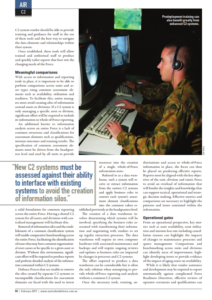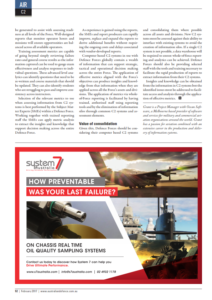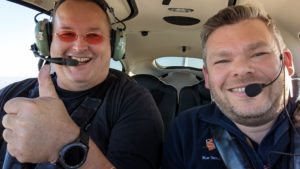
Evan & I in Cirrus SR22 VH-KJN
A couple of weeks ago, I went for a flight with my friend Evan in a
Cirrus SR22 G3, which is a four seat
general aviation (GA) aircraft. This particular aircraft is registered VH-KJN and amusingly referred to as “Cajun” or “Juliet.” The aircraft was manufactured in 2008 in the USA and brought over to Australia where it has flown ever since.
Manufactured by Cirrus Aircraft, the SR22 has become the world’s best selling GA aircraft, topping the annual sales charts since 2003. Together with the SR20, Cirrus are the most produced GA aircraft of the 21st Century. With sleek lines, plenty of safety features and a beautiful interior, it’s no wonder they’re extremely popular although the $1m to $2m price tag means many are owned by groups of pilots or companies/flying clubs/schools that then rent them out to approved pilots.
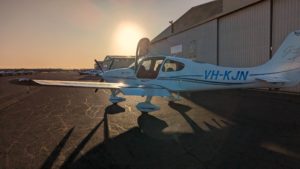
VH-KJN, a Cirrus SR22 G3
(Photo by Evan)
One of the safety features on all Cirrus aircraft is the whole aircraft ballistic parachute that can bring everything (and everyone on board) back to the ground safely in the event of pilot incapacitation, engine failure or other issues. Known as the
Cirrus Airframe Parachute System (CAPS), it has saved many lives and is considered a major selling point for many pilots, their significant-others and their passengers. Additional features include a strong composite airframe, a roll cage for the passenger cabin, seats designed to absorb vertical impact G-forces, a
glass cockpit with traffic displays, seatbelt airbags and more.
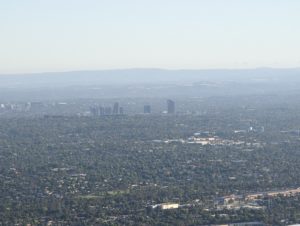
On our way towards the CBD, looking North through the smog towards the suburb of Box Hill which is turning into a mini-city of its own.
While I’ve flown in SR20s (and even a
Vans RV-10), I’ve don’t recall having ever flown in the flagship SR22 which features a more powerful engine, larger wing and greater fuel capacity than the SR20. Having taken Evan up in a hot air balloon some years back, we’d always been meaning to go for a flight where he was pilot in command. Finally in early January this year, the stars aligned and we agreed to go for an early morning flight out of Moorabbin airport so we could enjoy a couple of city orbits before it got hot and bumpy.
Taking this as a good excuse for a run in my recently restored 1982 RX-7, I left home early, driving down to meet Evan at his work by 0700. After a quick catch up and tour of the hangar, we stepped outside where I was introduced to VH-KJN. I was so busy checking out the aircraft and its features that I forgot to get photos of the aircraft itself. Ooops.
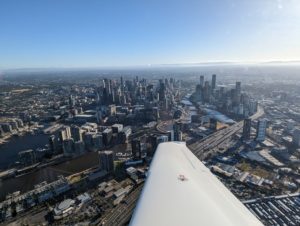
Good view of Melbourne showing the main CBD, the Yarra River, Southbank and the Docklands.
Getting in wasn’t too hard compared to some other aircraft I’ve flown in (especially the WW2 warbirds) although once again I was reminded that I could do with losing lots of kilos and maybe doing some stretches to improve my flexibility. There is a well placed handle to help get up on the wing (keep your feet on the non-slip surfaces within the marked areas) and then another sturdy handle within the cockpit to help as you lower yourself into the very comfortable seat. It’s like a luxury car interior with plenty of leather but a much, much better panel. It also has a four point harness as you might expect but the inertia reel belt on the shoulder is a nice touch and makes it all very comfortable. Another bonus is that it has a door on both sides (pilot & passenger) which is so wonderful when compared to some other GA aircraft (yeah, I’m looking at you
Piper and
Beechcraft!).
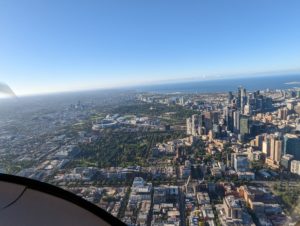
East & South of the CBD: Fitzroy Gardens, Olympic Precinct, Botanical Gardens, Albert Park Lake & on to the Bay
Once settled in, Evan started running through checklists (all displayed nicely on the screens – very handy), fired up the engine and then ran through a few more checks before taxiing down to the runup bay. We were early so Moorabbin tower hadn’t opened as yet, thus the airport was running under
Common Traffic Advisary Frequency (CTAF) procedures and there was almost no-one active on the radios. Moving through even more checklists, Evan ran the aircraft through its run-up and
magneto checks, verifying that all systems were good to go.
Evan then followed the taxiways to a suitable into-wind runway, checked for other traffic, made the appropriate radio calls and moved onto the runway. Demonstrating a short field take-off, he ran up the engine while using the brakes to keep us in place until, satisfied all was well, releasing the brakes and commencing the roll. With the airspeed increasing and the aircraft becoming lighter on its wheels, we both noticed a small flock of Galahs on the runway ahead of us. A member of the Cockatoo family of parrots, the little buggers were just sitting there starting to wonder what the damned noise was. No wonder Galah is a phrase meaning “idiot” in Australian slang…
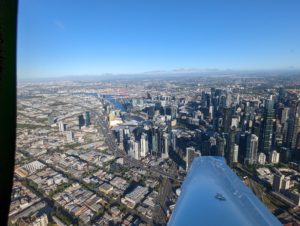
South of the CBD with Southbank, Freeway, Bolte Bridge and, in the distance, the Westgate Bridge.
Should you encounter birds while flying, the standard practice is, where possible, to go above them as they will typically dive out of the way of an approaching aircraft (if they have time, that is). Fortunately KJN had reached take-off speed and, as Evan lifted us off the runway, I watched as the birds finally realised they were in trouble and launched themselves into the air, staying low over the tarmac and racing off to the side and out of the way.
Happily in the air and established on climb out, Evan put us in a left hand circuit, climbing through the downwind leg and departing to the North of the airport. Once clear of Moorabbin’s airspace, he turned us towards Albert Park Lake and began getting ready to contact Essendon Tower.
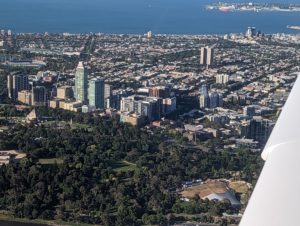
Sidney Myer Music Bowl, botanical gardens, Victoria Barracks and the Shrine.
While Moorabbin is Class D airspace when the tower is active, it sits in an area of Class G (uncontrolled) airspace to the South of Melbourne’s Central Business District (CBD) where the controlled airspace is above 2,500′. Further South and East of Moorabbin, the controlled airspace starts at 4,500′. So long as you stay below those altitudes, you can fly as you want provided you’re above the minimum altitude of 1,000′ over populated areas. As you get closer to the CBD, the lowest level of controlled airspace descends to 2,000′ and 1,500′ until, just south of the CBD, it’s all the way down to the surface. Aircraft can’t go into controlled airspace without clearances from Air Traffic Control (ATC) and, for a city orbit, you have to talk to ATC at Essendon Airport just North of the CBD (aka Essendon Tower) when it’s open, otherwise you’re talking to Melbourne Approach at the International airport to the Northwest of the CBD.
Evan called up Essendon Tower, got permission and we started a couple of right hand orbits around the city at about 1,500′. It was a beautiful morning with clear visibility and calm air, although there were a few bumps on the downwind side of the CBD. No surprise given all the buildings that were creating turbulence for us.

Caulfield Horse Racing Track
(I used to fly RC aircraft from the middle of this space)
After a pair of city orbits (and plenty of photos), we headed to the Southeast towards the Cranbourne area where we hoped to orbit the house of Steve, my co-host in the
Plane Crazy Down Under show. More photos were taken and the correct freeway was followed to get down to the area in question. We used some landmarks to determine where his house was likely to be and then did some left-hand and right-hand orbits in the area at about 2,500′ before heading West towards Frankston on the coast of Port Phillip Bay where we planned to start our run back to Moorabbin.
The intention was to be at about 1,500′ when we arrived at Frankston and, as we dropped below 2,000′ we started to get some bumps and shakes from turbulence. Checking the wind direction and strength displayed on the primary flight display screen, we could see it shifting and also changing speed, indicating we were descending through an inversion layer.
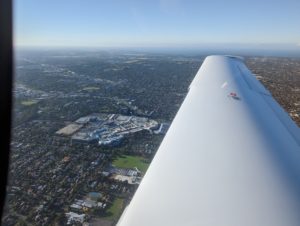
Any idea what this one is? Looks like a major shopping centre to the South East of Caulfield.
Arriving at Frankston we turned North and followed the coast up to the Southern Moorabbin reporting point at Carrum pier. By now Moorabbin Tower was operating so Evan called in and was instructed to join the downwind circuit for runway 13R. Descending further to 1,000′ the bumps continued, remaining with us all the way through the circuit until, on short final, everything settled down and Evan made a cracker landing.
Once off the runway, Evan went through his after landing checks, called Moorabbin Ground and received clearance to taxi with instructions to get back to the main aircraft parking area (generally referred to as the ramp or apron). During our taxi route we passed through a couple of “collision hot spots” where multiple runways and taxiways crossed but, fortunately, the taxi clearance had included approval to cross both inactive runways. It was during this time on the ground that we noticed the heat rising inside the cockpit, at which point Evan was able to turn on the airconditioning which cooled us back down quite quickly. Did I mention how much I enjoy being in a Cirrus?
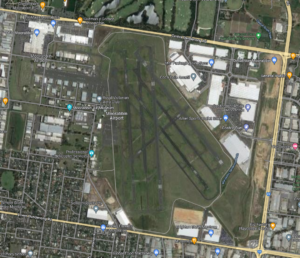
Moorabbin Airport
(via Google Maps)
Following a short time taxiing back to the parking area in front of the company hangar, Evan parked the aircraft and shut it down. We shook hands, got out and made sure the interior was clear of our gear (tablets, headsets, etc) and the harnesses were back the way they should be.
It was a cracker flight and a lot of fun so, to help say thanks, I took Evan for a drive in the RX-7 before dropping him back at work and heading for home. Suffice to say, my desire to get my fixed wing license has been rekindled and now I’m thinking about how to juggle my finances so I can get current again in hot air balloons AND finally finish my private pilot license.
Hmmm, maybe if my cunning plan for World Domination Through Lottery Win finally works…














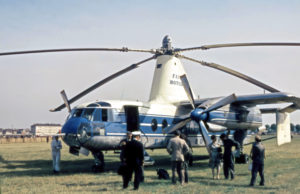
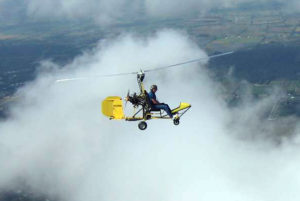
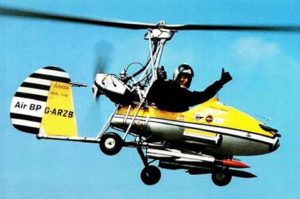
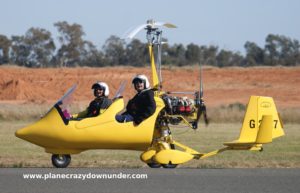
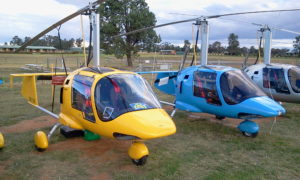

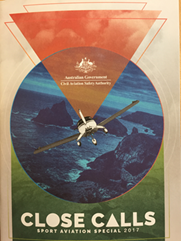

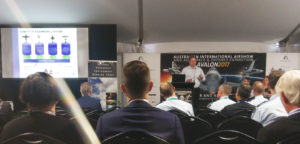

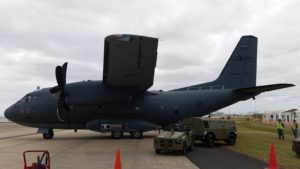





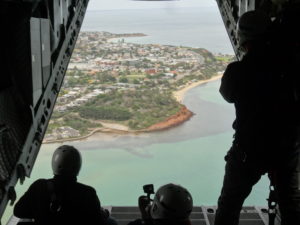

 In February this year I had an article published about data access and analytics in Australian Defence Magazine. Focusing on Command & Control (C2) systems and the issues that must be addressed in order to access and analyse the copious amounts of information contained within them, the article also discussed the importance of having a “Whole of force” view of the C2 system data.
In February this year I had an article published about data access and analytics in Australian Defence Magazine. Focusing on Command & Control (C2) systems and the issues that must be addressed in order to access and analyse the copious amounts of information contained within them, the article also discussed the importance of having a “Whole of force” view of the C2 system data.
